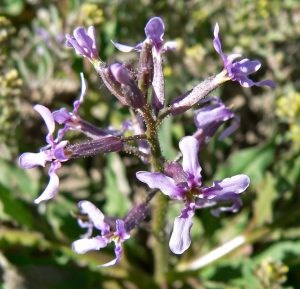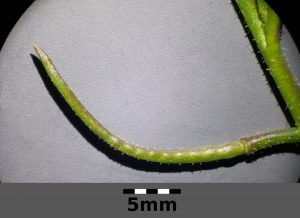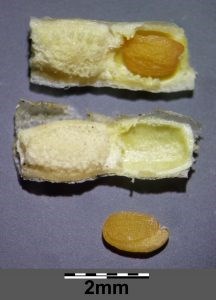This content was originally published by the Longmont Observer and is licensed under a Creative Commons license.
For the past few weeks I’ve been seeing carpets of purple flowers along the roadsides and sometimes in people’s lawns. I look forward to seeing these flowers, but it turns out there is so much more to them than I thought. The flowers are purple mustard and they will be in bloom until June.
Purple mustard plants belong to the Brassicaeae family, which appropriately enough, is the mustard family. Flowers in this family can be distinguished by having four petals and four sepals (green leaf-like structure on the outside of the petal), which gave rise to the other family name that used to be associated with the plant, Cruciferaceae. This is an old family name that was used before Brassicaceae was agreed on, and it alludes to the cross-shaped form of the flowers. Purple mustard is also known by the common name crossflower. Cruciferous vegetables, such as broccoli, Brussels sprouts, and cabbage belong in this family.

Purple mustard originally came from Asia and Europe but was brought to the US sometime in the 1700s and established itself. It did so well for itself that it is classified as a noxious weed in many places throughout the US. As mentioned, it can be found carpeting not only roadsides, but also whole fields. Purple mustard likes disturbed ground. Cows that graze on this plant will have milk that tastes and smells bad. In fact, if cows eat too much of this plant, their stomachs (yes, cows have more than one stomach) can become irritated, making the cow sick.
The leaves and stems of the purple mustard plant are sparsely covered in sticky, glandular hairs. The plant stalks are white and sometimes they are topped by a light brown gland. Flowers are produced toward the top of the stem. The flowers consist of four greenish-purple sepals that are partly fused into a quarter inch tube. Sepals are the part of the flower on the outside of the petal that look like a leaf. Flowers also have four purplish-pink petals that are narrow at the base and are about the same length as the sepals. The leaves are about three inches long in an oblong shape with wavy or toothed edges. When the plant goes to seed, it produces a seed pod (fruit) that is about two inches long and curved upwards. The seeds will overwinter and then sprout in the spring, bringing a multitude of new plants. Purple mustard is an annual plant. The plant itself exudes a strong, musky smell, leading to another of its common names, musk mustard. The plant can grow between six and 12 inches tall.

Despite its reputation as a nuisance and foul-smelling plant, purple mustard leaves and flowers are edible. Many describe its flavor as being similar to a radish. Others describe it as being similar to a mushroom. What flavor you get depends on the growing conditions. Dressed with oil and vinegar, the leaves make a delightful salad. As always, be sure you have properly identified the plant before eating it. Make sure to only gather leaves from plants you are sure have not been sprayed with herbicides. The leaves can be eaten raw in salads or on sandwiches. The flowers can be used to make flavored vinegar. Add a half cup of flowers to one pint of vinegar. The seeds can be used to make homemade mustard, but you would need a lot of seed pods to make it worth your while! Use them when they are dry and black in color and combine with vinegar to make a paste.
To harvest the plant, cut off the top four to six inches, including the flowers. Be sure to leave some flowers behind so that the plant will replenish itself the following spring. Raw leaves have a stronger flavor than cooked leaves. The leaves can be used in stir fries or baked into a dish. You can also chop the leaves and combine them with butter to make finger sandwiches. There is even a recipe for blue mustard tempura!

Look for patches of these flowers as you are out driving. There is one patch along 17th near Pace St. You may even be surprised to find some in your yard. If you are feeling adventurous and know that you have correctly identified the plant, try gathering some for eating. You may discover a new food you like!


